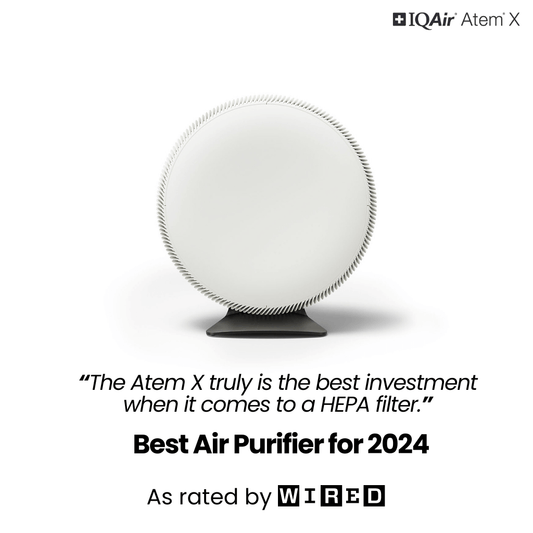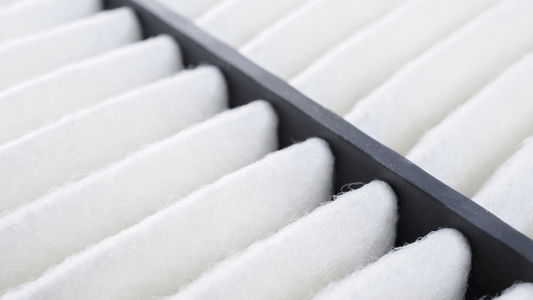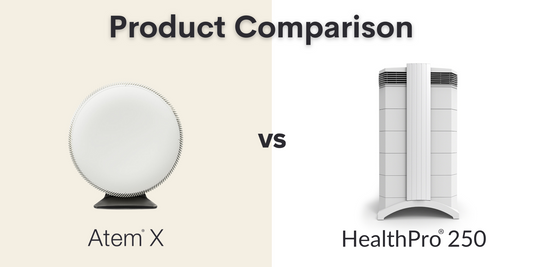In this Philips 3000 air purifier review we discuss Philips most recent air purifier. It is Philips first air purifier aimed at domestic customers, and there is currently only one model in the range. Philips as a company was founded in 1891 and started making and selling carbon-filament lamps. Today Philips has a large portfolio of electrical products they produce, ranging from TVs, dry shavers, toothbrushes, to alarm clocks, defibrillators, projectors, as well as computer monitors.
Pros:
- Looks nice
- High airflow
Cons:
- X Purifying fan
- X Small filters
- X Only fraction of airflow is cleaned
Introduction
The Philips air purifier can be bought from retailers such as Amazon, John Lewis, Maplin and Tesco, as well as directly from Philips. The price of the unit ranges from £360 - £390, at the time of writing you can purchase it directly from Philips for £380. The unit comes equipped with three basic filters, has 5 fan speed control settings and an "auto mode". The auto mode is supposed to adjust the speed of the fan to the pollution levels the unit seems to detect. The Philips air purifier has 4 different lights to indicate the supposed air quality detected. The unit also features a "sleep mode", on which the unit runs on the lowest speed setting, dims the power button, light on/off buttons and turns off all other lights on the display. The Philips air purifier also features a timer function whereby the unit can be set to operate from 1 – 24 hours and then turn off. To ensure no settings are changed, the unit also incorporates a child lock.
The Philips air purifier has box dimensions of H80 x W48 x D34 cm and has a shipping weight of 13Kg. The air purifier itself weighs in at 10Kg. There is no indication in the manual or on the Philips website as to how long the filters should last, but they can be bought directly from the Philips website. The “Nano Protect HEPA filter” is currently priced at £40 and the “Nano protect filter” costs £30 [1].
Marketing of the Philips 3000 Air Purifier
The Philips 3000 air purifier has been marketed as being able to “capture 99% of bacteria in only 1 hour”, as well as “99.97% of common airborne allergens”[3]. Philips claims that the Philips 3000 air purifier can “deliver 451 m3/hr of air in rooms measuring up to 95 m2”, while also being able to “remove Ultra-Fine Particles (UFP) down to 0.02µm”[4]. Philips says the unit removes “harmful gases like Formaldehyde, Toluene and TVOC’s”[5]. Philips similarly claim they have incorporated a “Real-time PM2.5 indicator” which displays “4 colours based on the indoor air quality”. In terms of filter life, Philips state their “Advanced Aerasense technology will accurately calculate filter life” based on the “indoor pollution levels, operation time and speed level”[6].
First Impressions

Philips 3000 air purifier packaging
The Philips air purifier comes in a white box with lots of stats, claims and images on all sides.
The air purifier itself is made out of glossy white plastic and has a large handle on the top back side - which makes lifting it relatively easy. The first thing you notice is the hole in the top front part of the unit, which functions to display the “air quality light”. The unit looks like it has a decent build quality and feels solid when picking it up. The unit does not have any castors, but as it only weighs 10Kg and has a flat base, it is easy enough to move around.
Philips 3000 Air Purifier Review - a Closer look
The Philips air purifier uses three types of filters. The “NanoProtect HEPA filter” and “NanoProtect filter” as Philips calls them. Both filters are packed in plastic bags, which need to be removed before you turn the unit on. To do so, you have to remove the front panel to gain access to the filters. This can be done by pulling on the bottom of the panel to remove it. The first filter is the ‘pre-filter’, you will need to press the two clips at the top and pull it towards you to remove it. Once removed and unpacked, place the filters back with the tab facing towards you and then secure the pre-filter back in place. The unit has five different fan speed control options, as well as ‘auto’, ‘allergen’ and ‘sleep’ mode. Upon turning the unit on, the ‘air quality light’, which - according to Philips represent the quality of air in the room [7] - will light up and briefly run through the four different colours.
Philips 3000 Air Purifier Review - Display and Features
The display is located on the top of the unit. It is made from a black plastic which looks good against the white of the rest of the unit. As is common with a display like this, it is prone to smudging. Fingerprints and dust become very visible on the display which is not the best look. On the left-hand side of the display, is the power button, then the child lock button, and the on/off light function. On the right-hand side, you have the fan speed button, the timer and the filter reset button.

The air quality sensor is located on the left-hand side of the unit. This device is supposedly providing “real-time PM2.5 feedback”[8]. The sensor is given the sophisticated and technically advanced sounding name of “advanced Aerasense sensor”. ‘Aerasense’ is a research division of Philips who "specialise in air quality improvement of hazardous ultra-fine particles" in the air [9]. Aerasense state that they collect and provide data related to the monitoring of airborne ultra-fine particles.
Just how accurate the sensor in the Philips air purifier is, is an important question to ask. A lot of air purifiers on the market today have this type of 'feature', especially the mid-level air purifiers like the Philips 3000 air purifier. Most of these units (i.e. all the ones we have seen), however, only offer a light scatter as a sensor. We tried to get an answer, but Philips did not confirm what kind of sensor the Philips air purifier uses. But for an overall price of £360, it is hard to imagine that it is anything else than a light scatter15. A sensor like that, unfortunately, can be quite inaccurate.
Now, in combination with the air quality sensor, Philips features something new in the Philips 3000 air purifier by introducing an "auto-lock function". This auto lock function is activated if the filter in the Philips air purifier is not replaced in time. The auto lock will effectively make the unit inoperable until the filter has successfully been replaced.
But here is the problem: a cheap sensor, will not be able to give you accurate air quality readings and this, in turn, will mean that the unit will not be able to calculate the filter life accurately. However, if the filter life is not calculated accurately, then the unit's auto-lock function will not work properly either, and you might end up with a unit that 'forces' you to replace the filter prematurely year in and year out.
Philips 3000 Air Purifier - Filtration
One of the major features Philips advertises about the Philips 3000 air purifier is its filtration efficiency. Here, Philips' claims seem a bit confusing. Philips states that the Philips 3000 Series air purifier is able to “capture 99.9% of bacteria in the first hour of use”[10], within a particle range of 0.3 - 10 microns. Philips says that this has been verified by a recent study [11]. In addition to this, they claim that 99% of all airborne particles such as dust, pet hair and pollen are also taken out of the air, but this time they don’t specify the time frame for how quickly the unit can do this. We tested the Philips 3000 for its filtration efficiency. Throughout the tests, we never achieved the claimed 99.97% at 0.3 microns.
Philips 3000 Air Purifier - Filters


Philips 3000 air purifier NanoProtect filter & Philips 3000 air purifier NanoProtect filter
The 'pre-filter' of the Philips air purifier is a simple plastic mesh that sits in front of the two other filters. It picks up the larger particles of dust including pet hair and (according to the manufacturer) can be cleaned with a hoover, plus it is washable. It is important to make sure that the pre-filter is dry before being put back into the unit. If the filter is still damp and put back into the unit, then this could lead to bacteria and mould growth in the unit.
Next is what Philips call a ’NanoProtect filter’, which is essentially a carbon filter. The carbon filter has a honeycomb design with active carbon pellets, which Philips claim to be able to remove ‘various gases, including harmful Total Volatile Organic Compounds and odours (TVOC)’. Despite this, Philips does not advertise what type of carbon is used in the filter. After contacting them, Philips informed us that they use "coconut shell based activated carbon". The use of coconut shell based carbon is not ideal for everyone as people with nut allergies might be sceptical about the prospect of exposing themselves to it. The third filter is the ‘NanoProtect HEPA filter’ which has a surface area of 2m2 [12]. 2m2 is on the low side for being the only proper particle filter in the unit.
PHILIPS 3000 AIR PURIFIER review - FILTER life
When it comes to the life of the filters there is no indication anywhere (not on the Philips website or re-seller sites) as to when you may need to replace them. This is a bit disappointing as it can help you plan if the unit will be cost-effective or not. We contacted Philips to see if they could give us any indication as to how long the filters will last. The customer service person said he did not know and that giving an estimate "is not possible" as it depends on the "air quality", and "how the unit is operated". Well, that is not very helpful and a bit too simplistic. Imagine buying a car and being told that they cannot give you the miles per gallon it uses, as that depends on “how the car is operated?”. Obviously, it is right that one cannot provide an exact number of hours for your specific unit, but with a little experience and product knowledge they should be able to provide an average, just as you do with the mileage per gallon of a car.
Furthermore, the Philips 3000 air purifier filter life indicator, supposedly calculates the hours the unit has been used for and based on these numbers tells you when the filter needs to be replaced. So Philips must have an idea of what the “miles per gallon” for the Philips air purifier is, but for some reason, they seem unable or unwilling to tell you.
PHILIPS 3000 AIR PURIFIER - Gas & Chemical Filtration
When it comes to removing gases, chemicals and odours, the key is to use high quality activated granular carbon and plenty of it. The filter weight of the NanoProtect filter, which includes the carbon pellets and the filter frame, weighs only 475 grams in total. We can very conservatively assume that the total amount of carbon is not more than 450 grams. But if you compare this to the 900 grams of carbon a unit like the Blueair 205 SmokeStop uses, then this is a big jump. Using twice as much carbon will provide a significant difference in the amount of gas and chemicals it can filter out. Also, due to the small amount of carbon used and the structure of the honeycomb design, air - and thus gases, chemicals and odours - will be able to easily pass through the filter without going through the carbon, and thus without being filtered.
Philips 3000 Air Purifier - Healthy air protect lock
This 'Air Protect lock" is a bit odd: As mentioned earlier, Philips designed the Philips air purifier to stop operating and automatically lock itself if the filter in it is not replaced within 2 weeks after the filter indicator has come on. Philips calls this feature, the 'healthy air protect lock'[13]. Philips state that "the appliance stops functioning to avoid running with no effect as the filter is no longer effective". This is so that "you are assured of healthy air, always".
Why is this odd you ask? There are a couple of reasons. If your filter is a bit late being delivered or you forgot to order one, you won’t be able to use the unit. You can then either not use the unit and wait until you get a new filter, or just reset the filter indicator and hope that this will unlock the unit for use. Either option is not ideal.
Philips 3000 Air Purifier - Airflow
Airflow is another very important factor when considering an air purifier. The unit has 5 different speed settings and the decibel level ranges from 33 dB(A) – 64 dB(A)[16]. The airflow rates are 84 m3/hr on speed 1, 110 m3/hr on speed 2, 232 m3/hr on speed 3, 326 m3/hr on speed 4 and 451 m3/hr on speed 5.
On the lowest speed setting, the unit is quiet and does not make a lot of noise; which makes it suitable for use in the bedroom. Speed setting 2 or 3 might be the most useful in terms of performance and noise levels in a sleep or work environment, whereas speed settings 4 and 5 are a bit too noisy for day to day and certainly night-time use. With the addition of a basic timer, the unit can be programmed to turn off between 1 – 24 hours which is a pretty standard feature for air purifiers in this price range.
PHILIPS 3000 air purifier Review Summary
The Philips 3000 air purifier is a midrange air purifier with decent build quality and aesthetics. The unit is easy to move around and the lack of castors is not a great loss. In terms of replacement filters, Philips does not provide any indication of how long the filters will last. This is a little disappointing as customers want to know the approximate running costs of the unit, which is an important factor when considering which air purifier to go for.
In terms of performance, the Philips performed as we expected considering the price - although the claimed filtration efficiency was not reached.
We are not so impressed with the "auto lock function". You have 14 days to replace the filter otherwise the unit will stop operating and is locked. This is a bit of a worry as you could be stuck with an air purifier which will not work. Furthermore, this function's accuracy is relying on a very accurate built-in air quality monitor. At this price point, that is a bit tough.
A good air quality monitor for particulate pollution can cost anywhere from £200 - £2000. An accurate and low-cost model, for example, is the AirVisual Pro Air Quality Monitor. All the air quality monitors in air purifiers that we tested are not accurate enough to do what Philips is trying to do. Philips does not provide much information about the air quality monitor in the Philips 3000 air purifier or how it works, which gives us even more reason to be a bit sceptical if it can actually accurately calculate the air quality and the filter life. But if the air quality sensor in the Philips 3000 is not sophisticated enough, readings will be inaccurate. Remaining filter life will be calculated incorrectly, the unit will shut down and buyers will not get the performance they need or want and could significantly overpay in filter cost...
With the Philips being a midrange air purifier, it exhibits certain traits which seem popular among other air purifiers in this price range. As such, the Philips 3000 air purifier is comparable to the MeacoClean CA-HEPA 119x5 in most of its features. Both are at a similar price point, have the same number and filter configuration, while also offering the standard 2 years warranty. They both have similar speed options and basic features like a timer, auto and sleep modes. In addition, both offer lower than claimed levels of filtration efficiency. In this regard, the Philips 3000 air purifier does not bring anything new to the table in terms of performance or features.
Below is a table comparing the Philips 3000 and the MeacoClean CA-HEPA 119x5 air purifiers.

*Based on spot measurement with a high-quality laser particle scanner.
The Philips 3000 air purifier is a good mid-range unit overall. If you are serious about traffic pollution, suffer from asthma or have more serious allergy symptoms, however, you might not be happy with less then HEPA performance. A proper leakage free HEPA air purifier might be needed.
- http://www.philips.co.uk/c-m-ho/antiallergen/overview#philips_anti-allergen
- http://www.philips.co.uk/c-p/AC3256_30/3000-series-air-cleaner
- http://www.philips.co.uk/c-m-ho/air-purifier-and-air-humidifier
- http://www.philips.co.uk/c-p/AC3256_30/3000-series-air-cleaner#see-all-benefits
- http://www.philips.co.uk/c-p/AC3256_30/3000-series-air-cleaner
- http://www.philips.co.uk/c-p/AC3256_30/air-purifier-anti-allergen-with-nanoprotect-filter
- Page 10 of the Philips 3000 user manual
- http://www.philips.co.uk/c-p/AC3256_30/3000-series-air-cleaner
- http://www.aerasense.com/index.php?pageID=32
- http://www.philips.co.uk/c-m-ho/air-purifier-and-air-humidifier
- ‘Shanghai institute of measurement and testing technology (SIMT) in 30m3 chamber, according to GB21551.3-2010 (Staphylococcus albsp) 8032 as testing bacteria. http://www.philips.co.uk/c-m-ho/air-purifier-and-air-humidifier [‘Shanghai institute of measurement and testing technology (SIMT) in 30m3 chamber, according to GB21551.3-2010 (Staphylococcus albsp) 8032 as testing bacteria]
- http://www.philips.co.uk/c-p/FY3433_10/nanoprotect-hepa-filter#see-all-benefits
- Page 15 of Philips manual
- https://www.amazon.co.uk/product-reviews/B01BSH2WJ0/ref=cm_cr_dp_hist_three?ie=UTF8&filterByStar=three_star&reviewerType=all_reviews&showViewpoints=0
- http://www.philips.co.uk/c-p/AC3256_30/3000-series-air-cleaner
- http://www.philips.co.uk/c-p/AC3256_30/air-purifier-anti-allergen-with-nanoprotect-filter




